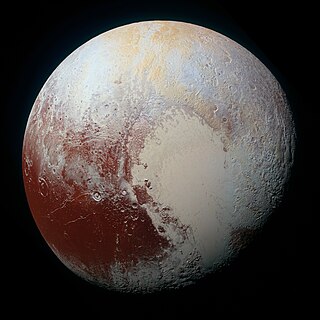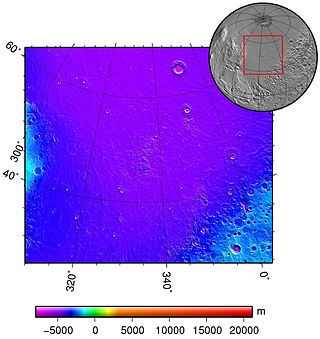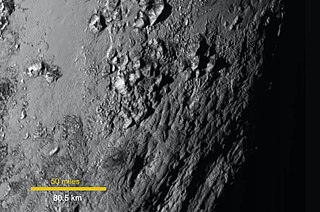
Pluto is a dwarf planet in the Kuiper belt, a ring of bodies beyond the orbit of Neptune. It is the ninth-largest and tenth-most-massive known object to directly orbit the Sun. It is the largest known trans-Neptunian object by volume, by a small margin, but is less massive than Eris. Like other Kuiper belt objects, Pluto is made primarily of ice and rock and is much smaller than the inner planets. Pluto has only one sixth the mass of Earth's moon, and one third its volume.

Charon, known as (134340) Pluto I, is the largest of the five known natural satellites of the dwarf planet Pluto. It has a mean radius of 606 km (377 mi). Charon is the sixth-largest known trans-Neptunian object after Pluto, Eris, Haumea, Makemake, and Gonggong. It was discovered in 1978 at the United States Naval Observatory in Washington, D.C., using photographic plates taken at the United States Naval Observatory Flagstaff Station (NOFS).

A cryovolcano is a type of volcano that erupts gasses and volatile material such as liquid water, ammonia, and hydrocarbons, collectively referred to as cryolava, from a reservoir of subsurface cryomagma. These eruptions can take many forms, such as fissure and curtain eruptions, effusive cryolava flows, and large-scale resurfacing, and can vary greatly in output volumes. Immediately after an eruption, cryolava quickly freezes, constructing geological features and altering the surface.

The geology of Pluto consists of the characteristics of the surface, crust, and interior of Pluto. Because of Pluto's distance from Earth, in-depth study from Earth is difficult. Many details about Pluto remained unknown until 14 July 2015, when New Horizons flew through the Pluto system and began transmitting data back to Earth. When it did, Pluto was found to have remarkable geologic diversity, with New Horizons team member Jeff Moore saying that it "is every bit as complex as that of Mars". The final New Horizons Pluto data transmission was received on 25 October 2016. In June 2020, astronomers reported evidence that Pluto may have had a subsurface ocean, and consequently may have been habitable, when it was first formed.
Satélite de Coleta de Dados is a series of satellites developed in Brazil.

Eris is the most massive and second-largest known dwarf planet in the Solar System. It is a trans-Neptunian object (TNO) in the scattered disk and has a high-eccentricity orbit. Eris was discovered in January 2005 by a Palomar Observatory–based team led by Mike Brown and verified later that year. In September 2006, it was named after the Greco–Roman goddess of strife and discord. Eris is the ninth-most massive known object orbiting the Sun and the sixteenth-most massive overall in the Solar System. It is also the largest known object in the solar system that has not been visited by a spacecraft. Eris has been measured at 2,326 ± 12 kilometers (1,445 ± 7 mi) in diameter; its mass is 0.28% that of the Earth and 27% greater than that of Pluto, although Pluto is slightly larger by volume. Both Eris and Pluto have a surface area that is comparable to the area of Russia or South America.

Acidalia Planitia is a plain on Mars, between the Tharsis volcanic province and Arabia Terra to the north of Valles Marineris, centered at 49.8°N 339.3°E. Most of this region is found in the Mare Acidalium quadrangle, but a small part is in the Ismenius Lacus quadrangle. The plain contains the famous Cydonia region at the contact with the heavily cratered highland terrain.

Tartarus Colles are a group of knobby hills in the northern plains of Mars.

Astapus Colles is a group of hills in the Casius quadrangle of Mars, located at 35.5 North and 272.3 West. It is 580 km across and was named after an albedo feature at 35N, 269W. The term "Colles" is used for small hills or knobs.

Tombaugh Regio, sometimes called "Pluto's heart" after its shape, is the largest bright surface feature of the dwarf planet Pluto. It is just north of the equator, to the northeast of Belton Regio and to the northwest of Krun Macula, which are both dark features. Its western lobe, a 1,000 km (620 mi)-wide plain of nitrogen and other ices lying within a basin, is named Sputnik Planitia. The eastern lobe consists of high-albedo uplands thought to be coated by nitrogen transported through the atmosphere from Sputnik Planitia, and then deposited as ice. Some of this nitrogen ice then returns to Sputnik Planitia via glacial flow. The region is named after Clyde Tombaugh, the discoverer of Pluto.

Belton Regio is a prominent surface feature of the dwarf planet Pluto. It is an elongated dark region along Pluto's equator, 2,990 km (1,860 mi) long and one of the darkest features on its surface.

The geology of Charon encompasses the characteristics of the surface, crust, and interior of Pluto's moon Charon. Like the geology of Pluto, almost nothing was known of Charon's geology until the New Horizons of the Pluto system on 14 July 2015. Charon's diameter is 1,208 km (751 mi)—just over half that of Pluto. Charon is sufficiently massive to have collapsed into a spheroid under its own gravity.

The geography of Pluto is mainly focused the distribution of physical features across Pluto. On 14 July 2015, the New Horizons spacecraft became the first spacecraft to fly by Pluto. During its brief flyby, New Horizons made detailed geographical measurements and observations of Pluto and its moons.

The Tenzing Montes are a range of icy mountains on Pluto, bordering the southwest region of Sputnik Planitia and the nearby Hillary Montes and Wright Mons. With peaks reaching 6.2 km in height, they are the highest mountain range on Pluto, and also the steepest, with a mean slope of 19.2 degrees.

Sputnik Planitia is a large basin on Pluto, about 1,400 by 1,200 km in size, partially submerged in large, bright glaciers of nitrogen ice. Named after Earth's first artificial satellite, Sputnik 1, it constitutes the western lobe of the heart-shaped Tombaugh Regio. Sputnik Planitia lies mostly in the northern hemisphere, but extends across the equator. Much of it has a surface of irregular polygons separated by troughs, interpreted as convection cells in the relatively soft nitrogen ice. The polygons average about 33 km (21 mi) across. In some cases troughs are populated by blocky mountains or hills, or contain darker material. There appear to be windstreaks on the surface with evidence of sublimation. The dark streaks are a few kilometers long and all aligned in the same direction. The planitia also contains pits apparently formed by sublimation. No craters were detectable by New Horizons, implying a surface less than 10 million years old. Modeling sublimation pit formation yields a surface age estimate of 180000+90000
−40000 years. Near the northwest margin is a field of transverse dunes, spaced about 0.4 to 1 km apart, that are thought to be composed of 200-300 μm diameter particles of methane ice derived from the nearby Al-Idrisi Montes.

The Hillary Montes or are a mountain range that reach 3.5 km above the surface of the dwarf planet Pluto. They are located northwest of Tenzing Montes in the southwest border area of Sputnik Planitia in the south of Tombaugh Regio. The Hillary Montes were first viewed by the New Horizons spacecraft on 14 July 2015, and announced by NASA on 24 July 2015.
Morgoth Macula is the informal name for a small dark region on the surface of Pluto, southwest of the Norgay Montes and adjacent to Sputnik Planitia. It was discovered in 2015 by the spacecraft New Horizons and named after Morgoth, the primary antagonist in J.R.R. Tolkien's legendarium.
Challenger Colles is a range of hills on Pluto near the eastern edge of Sputnik Planitia. Discovered by the New Horizons team in July 2015, It is named in honor of the Space Shuttle Challenger, which was destroyed with all seven crew lost on January 28, 1986. The name Challenger Colles was officially approved by the International Astronomical Union on May 27, 2022.

Wright Mons is a large, roughly circular mountain and likely cryovolcano on the dwarf planet Pluto. It is located southwest of Sputnik Planitia near the center of the low-lying Hyecho Palus region, adjacent to the Tenzing Montes and Belton Regio. A relatively young geological feature, Wright Mons has attracted attention as one of the most apparent examples of recent geological activity on Pluto.



















